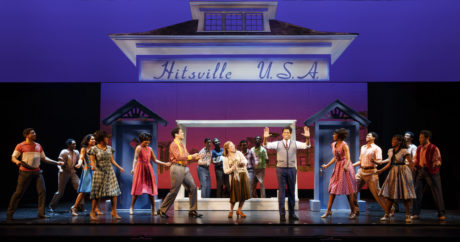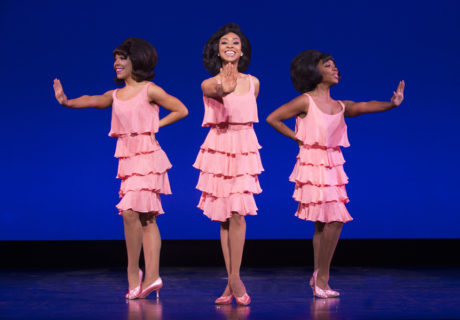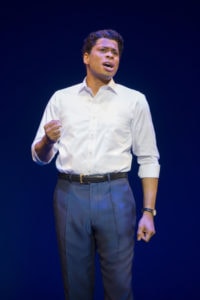Bringing Detroit’s soulful music to the masses was the goal, and Berry Gordy showed he was ready for the challenge by creating the melodies of Motown. Written for the stage by Gordy (adapted from his own memoir), Motown The Musical is now onstage at the Academy of Music in Philadelphia, as part of the Broadway Philadelphia series.

The musical begins with a dejected Berry (Chester Gregory), the founder and longtime leader of Motown Records, feeling betrayed by his former stars and unwilling to attend the 1983 television special celebrating Motown’s 25th anniversary. Both the harshness and opportunity of the music industry are shown throughout the show via flashbacks, starting with the opening of Motown’s first headquarters, known as “Hitsville U.S.A.” Newcomers and superstars of Motown music take turns supporting each other and bringing each other down, following one of Gordy’s mantras: “competition breeds success.” Tension between groups (The Four Tops vs. The Temptations) is a source of play-fighting throughout the show, as a joint medley between the two groups is treated more as a sing-off battle than a display of harmony.
Gregory is wonderful as Gordy, laboring to keep his Motown dream alive while fighting outside influences that hope to tempt his artists with dollar signs to leave the label. His chemistry with Allison Semmes as Diana Ross is evident as the two tell the story of their long romantic relationship with songs such as “I Hear a Symphony.” Semmes is amazing as Ross, embodying the diva and wowing the crowd, especially when she invited two audience members to join her in “Reach Out and Touch.”
As the show tells a story that spans nearly 50 years, the audience watches as the fashion morphs from pastel pencil skirts and beehives to glittery ruffled tuxedo shirts and Afros. Thanks to the costume design by Emilio Sosa and hair and wig design by Charles G. LaPointe, the audience – an eclectic mix of baby boomers and younger fans – was happily transported back to its youth.
Director Charles Randolph-Wright blends the fast-paced scenes smoothly. There are over 50 Motown hits, as well as several appealing original songs written by Gordy and Michael Lovesmith, layered in the production.
The automated scenic design by David Korins not only helps tell the story, it also makes the show possible. It allows scenes to move quickly, historical events to be shown without distraction, and different locations to scroll in and out of view when a physical scenery change would be too slow. The history of Motown’s success is mapped on travelling flats (vertical set pieces) that slide back and forth without noise or effort that help transition all or part of the stage. The flats display patterns, backdrops, curtains, theater marquees, light bars, title cards, dates, times, locations, doorways, storefronts and interiors of different houses. It’s all so impressive and immersive that it may make you wonder what the future of physical scene changes will be, given the quality and efficiency seen in this show.

The Civil Rights Movement of the 1960s is a major focus of Motown, and the challenges that many African-Americans faced are shown not only in the dialogue but also in the music. Although important, certain aspects of the Civil Rights Movement within a musical might feel tacked on or simply “lip service.” Not here. In Motown, these pivotal moments of American history actually unlock the original meanings of these songs and reveal why the lyrics of some songs (“Ball of Confusion” and “What’s Goin’ On”) were penned the way they were.

During these quick looks at history, the show does not allow us to stay in any place (or time) for very long. It doesn’t allow us to celebrate too long or mourn too deliberately. The opening of Hitsville U.S.A. (in a scene from 1959) is accompanied by a song of promise (“Get Ready”), whereas the ’60s assassinations and Vietnam are treated (in a somewhat heavy-handed manner) with a version of Edwin Starr’s “War.” Sometimes this fast pace works, sometimes it doesn’t. Audiences come with their own memories of these songs, and Motown would flow better if it allowed theatergoers more time to unpack their own memories.
All of these songs are brought to life by Motown’s large ensemble, with almost all playing multiple roles. Raymond Davis Jr., who plays Young Berry Gordy/Young Stevie Wonder/Young Michael Jackson (alternating with CJ Wright in the role), brought down the house with his take on Michael in a scene where the Jackson 5 auditions for Gordy.
While some might dismiss Motown as an extended tribute show; it stands way above jukebox musicals such as Movin’ Out. It’s half-concert, half-storyline, almost like a concept album turned inside out. With its immortal songs, terrific performances and innovative design, it tells the personal stories of the days when Gordy ruled Hitsville U.S.A., and artists such as Marvin Gaye, The Marvelettes, Smokey Robinson, and The Supremes ruled the airways.
Running Time: Two hours and 45 minutes, with an intermission.
Motown The Musical plays through June 11, 2017, and is presented by The Kimmel Center for the Performing Arts at the Academy of Music – 240 South Broad Street, in Philadelphia, PA. For tickets, call (215) 893-1999, or purchase them online.





